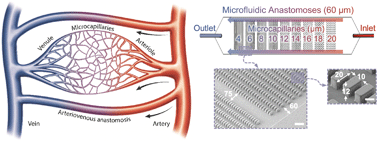Microfluidic assessment of red blood cell mediated microvascular occlusion†
Abstract
Abnormal red blood cell (RBC) deformability contributes to hemolysis, thrombophilia, inflammation, and microvascular occlusion in various circulatory diseases. A quantitative and objective assessment of microvascular occlusion mediated by RBCs with abnormal deformability would provide valuable insights into disease pathogenesis and therapeutic strategies. To that end, we present a new functional microfluidic assay, OcclusionChip, which mimics two key architectural features of the capillary bed in the circulatory system. First, the embedded micropillar arrays within the microchannel form gradient microcapillaries, from 20 μm down to 4 μm, which mimic microcapillary networks. These precisely engineered microcapillaries retain RBCs with impaired deformability, such that stiffer RBCs occlude the wider upstream microcapillaries, while less stiff RBCs occlude the finer downstream microcapillaries. Second, the micropillar arrays are coupled with two side passageways, which mimic the arteriovenous anastomoses that act as shunts in the capillary bed. These side microfluidic anastomoses prevent microchannel blockage, and enable versatility and testing of clinical blood samples at near-physiologic hematocrit levels. Further, we define a new generalizable parameter, Occlusion Index (OI), which is an indicative index of RBC deformability and the associated microcapillary occlusion. We demonstrate the promise of OcclusionChip in diverse pathophysiological scenarios that result in impaired RBC deformability, including mercury toxin, storage lesion, end-stage renal disease, malaria, and sickle cell disease (SCD). Hydroxyurea therapy improves RBC deformability and increases fetal hemoglobin (HbF%) in some, but not all, treated patients with SCD. HbF% greater than 8.6% has been shown to improve clinical outcomes in SCD. We show that OI associates with HbF% in 16 subjects with SCD. Subjects with higher HbF levels (HbF > 8.6%) displayed significantly lower OI (0.88% ± 0.10%, N = 6) compared with those with lower HbF levels (HbF ≤ 8.6%) who displayed greater OI (3.18% ± 0.34%, N = 10, p < 0.001). Moreover, hypoxic OcclusionChip assay revealed a significant correlation between hypoxic OI and subject-specific sickle hemoglobin (HbS) level in SCD. OcclusionChip enables versatile in vitro assessment of microvascular occlusion mediated by RBCs in a wide range of clinical conditions. OI may serve as a new parameter to evaluate the efficacy of treatments improving RBC deformability, including hemoglobin modifying drugs, anti-sickling agents, and genetic therapies.

- This article is part of the themed collection: Microfluidics for hematology


 Please wait while we load your content...
Please wait while we load your content...